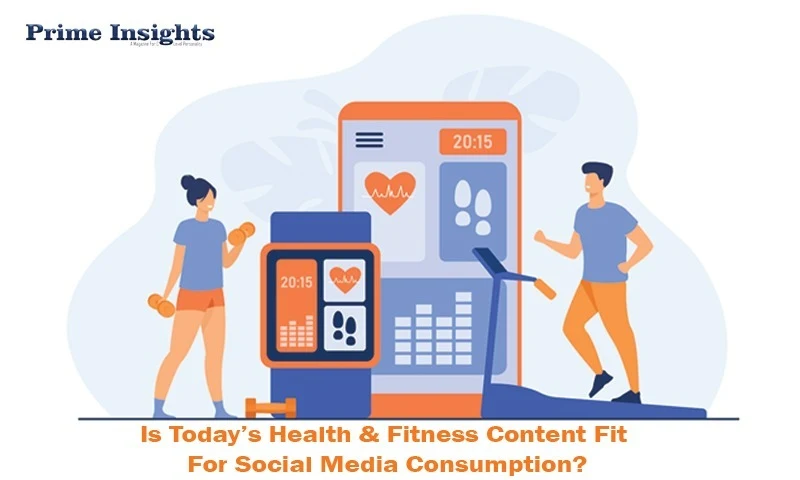Health & Fitness Content Fit For Social Media Consumption
Does there need to be a paradigm shift in the way we consume health-related information online?
In an age of ‘before & after’ transformations, fitness trackers, 30-day challenges & posts that included ‘#shredded’, ‘#ripped’ or ‘#hotbod’, it’s clear that the world of health and fitness is changing. But is the content currently consumed by the Indian public, especially on social media, fit for purpose, or are we ripe for a pivot?
It started with Orkut galleries & communities, expanded to fitness forums and discussions, progressed to include motivational stories & videos, and now permeates mobile apps & wearable technology. Today, health and fitness content is everywhere, making people’s lives better. But take a closer look, and you’ll find that the content we read, like, share and subscribe has its downsides as well.
Come, let’s look at the various sides of contemporary health & fitness content and decide for ourselves if it is fit for social media consumption.
Abundance
Every fitness journey – be it physical, mental or spiritual – has its set of barriers. One requires daily doses of motivation to reach goals, and that’s where inspiring fitness quotes, transformation stories and pumped-up music have played a key role. For decades now, such content has offered valuable psychological encouragement, leading people to adopt healthy behaviours and promoting positivity.
But more often than not, the sheer volume of fitness possibilities we are bombarded with today can feel paralyzing. If you think it’s hard deciding what gym to join in your neighbourhood, it’’ll be a lot harder to decide which YouTuber to follow from the millions of results you get on searching “fitness videos.” What’s more, just like anything else, an overdose of motivation can make one set unrealistic expectations, and set oneself for failure. Saying “I’m doing my best, but I can’t do it” to your fitness role model, or the trainer who believes in you feels like you’re turning them down. Not to mention the browbeat or FOMO (fear of missing out) one experiences today for not being in good shape.
Free availability
A connection to the Internet is a powerful tool, linking you to just about all the knowledge in the world. From home remedies to healthy recipes and weight loss diets to workout plans, every type of health & fitness content is available at our fingertips today. This is no less than a boon, especially in challenging times such as the COVID-19 pandemic. More than just satisfying your curiosity, this content guides you to wellness, wards off confusion and raises awareness.
But this free availability of information does as much harm as good. We should be happy we can Google ‘natural alternatives to treat sinuses’ and save time & money on a consultation. However, we must also be aware that this information cannot replace a Doctor’s expertise. And for good reason! A fair amount of health & fitness content online is full of misleading data, false claims, outdated statistics and misinterpretations – all peddled by influencers or marketers for fame or money.
Additionally, the content is not tailored to one’s individual needs. For instance, very few online fitness programs enable the instructor to check your form or offer corrections based on your performance. You might keep working out incorrectly, even unsafely, without realizing it.
Technology
Today, many healthcare apps have been shown to improve patient outcomes; some have the potential to reduce morbidity and mortality. Many studies show that weight loss tracking apps increased compliance and focus when compared to traditional programmes. At the same time, nutrition & exercise apps lead one towards a disciplined life.
But despite no evidence of harm, there still are several drawbacks. Many of these apps are created by tech firms outside the healthcare sector aiming to turn smartphones into medical devices. These are untested and unscientific apps that use the FREEMIUM model to play on the fears of an unhealthily health-obsessed generation and make money.
Privacy
Ever since social media has taken the limelight, the way we share pictures & videos has changed. Earlier, we rarely shared our most private selfies outside closed circles. Nowadays, it takes only a few clicks for us to flaunt them on social media. Now, this is a great way to gain likes and comments for motivation or let your followers know you’ve reached a major health milestone. But turning the lens on oneself comes with its own set of problems.
Today, the Web is brimming with people’s most intimate photographs, especially of women. Unfortunately, most of these pictures are fitness selfies that are morphed and misused in dating scams, social media crimes or adult websites. But even if such health & fitness images and videos are shared willingly or under copyright licenses, there’s still the fact that it gets reshared worldwide, thereby increasing the chances of someone invading one’s privacy or taking credit.
The big question
So, do we need to step away from today’s health & fitness content? Maybe not! Perhaps the right thing to do is put it under the proverbial scope and moderate our digital consumption – reaping the benefits of free, abundant information while maintaining our privacy, all the while realizing that it’s not perfect. That in the end, we are our own best judge.

